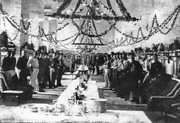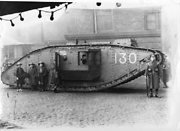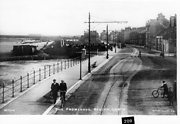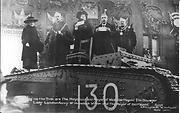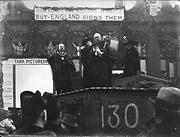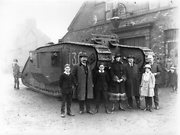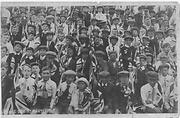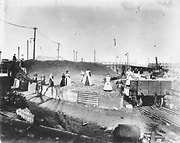 Hartlepool Sports & Leisure
Hartlepool Sports & Leisure
- Cinemas, Theatres & Dance Halls
- Musicians & Bands
- At the Seaside
- Parks & Gardens
- Caravans & Camping
- Sport
 Hartlepool Transport
Hartlepool Transport
- Airfields & Aircraft
- Railways
- Buses & Commercial Vehicles
- Cars & Motorbikes
- The Ferry
- Horse drawn vehicles
 A Potted History Of Hartlepool
A Potted History Of Hartlepool
- Unidentified images
- Sources of information
- Archaeology & Ancient History
- Local Government
- Printed Notices & Papers
- Aerial Photographs
- Events, Visitors & VIPs
 Hartlepool Trade & Industry
Hartlepool Trade & Industry
- Trade Fairs
- Local businesses
- Iron & Steel
- Shops & Shopping
- Fishing industry
- Farming & Rural Landscape
- Pubs, Clubs & Hotels
 Hartlepool Health & Education
Hartlepool Health & Education
- Schools & Colleges
- Hospitals & Workhouses
- Public Health & Utilities
- Ambulance Service
- Police Services
- Fire Services
 Hartlepool People
Hartlepool People
 Hartlepool Places
Hartlepool Places
 Hartlepool at War
Hartlepool at War
 Hartlepool Ships & Shipping
Hartlepool Ships & Shipping

Home Front - First World War
Details about Home Front - First World War
Photos and stories relating to the Hartlepool Home Front during the First World War.
Location
Related items :
 1917 - the Rice family
1917 - the Rice family
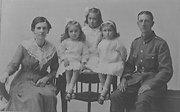 Donated by Mr. John Watson
Donated by Mr. John WatsonDated 1917
A 1917 family photograph of Jack and Ethel Rice, with their three children Olive, Evelyn and Peggy. Jack was gassed during the war.
More detail » Adolph Coles Charlton - Memoriam card
Adolph Coles Charlton - Memoriam card
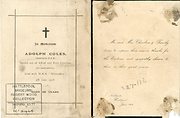 Created by unknown
Donated by Hartlepool Museum Service
Created by unknown
Donated by Hartlepool Museum ServiceA Memoriam card for Adolph Coles Charlton.
More detail » Alice Wainwright and children - 1915
Alice Wainwright and children - 1915
 Created by unknown
Donated by Mr. Neil Wainwright
Created by unknown
Donated by Mr. Neil WainwrightA 1915/16 photograph of Alice Annie Wainwright (nee Huntley), and her children.
More detail » Bedford Street Peace Tea
Bedford Street Peace Tea
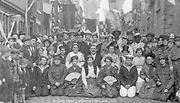 Donated by Mr. John Cambridge
Donated by Mr. John CambridgeA Peace Tea in Bedford Street, Hartlepool in 1919.
More detail » Convalescent soldiers
Convalescent soldiers
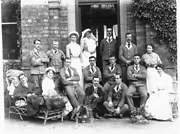 Donated by Douglas Ferriday
Donated by Douglas FerridayPart of the Hartlepool Library Services collection
Dated 1915
Convalescent soldiers and their nurses at the Voluntary Aid Detachment Hospital at Normanhurst circa 1915,
HHT&N 928
More detail » Convalescing soldiers
Convalescing soldiers
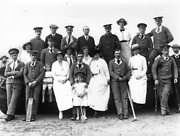 Donated by Hartlepool Library Service
Donated by Hartlepool Library ServiceConvalescing soldiers on a day trip to the coast c1915. Normanhurst on Wooler Road was used as a convalescent home during the first world war. There is a nurse in the centre of the picture with a few other helpers as well.
HHT&N 510
More detail » Derwent Street Peace Tea
Derwent Street Peace Tea
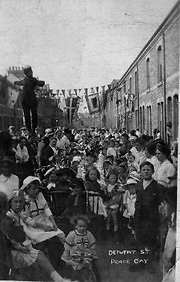 Donated by Mr. Neil Wainwright
Donated by Mr. Neil WainwrightDated 1919
A Peace Tea held in Derwent Street, probably in 1919. No-one in this photograph has yet been identified.
More detail » Derwent Street Peace Tea (2)
Derwent Street Peace Tea (2)
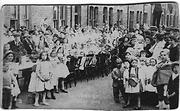 Donated by Mr. Neil Wainwright
Donated by Mr. Neil WainwrightDated 1919
A postcard of a party held in Derwent Street, in 1919, to celebrate peace. All members of the Applegarth family. They are; Frederick William in front all white 4th. from right, immediately behind him is Frances Emma in the cap, behind her is their mother Frances Ellen Applegarth nee Jolly holding aloft the baby James Douglas.
More detail » Egbert and Nelson
Egbert and Nelson
Images of the WW1 tanks 'Egbert' and 'Nelson', made famous through the generosity of townspeople in subscribing to National War Bonds.
More detail » Egg Imports
Egg Imports
The following is an extract from 'HistoriclalNotes and Personal Recollections of West Hartlepool and its Founders', by Major Robert Martin (1924):
"At one time West Hartlepool enjoyed the reputation of importing and preserving more foreign eggs than any port in the kingdom. 10,000 tons of eggs were imported every year from foreign countries. Worked out at eleven cases to the ton and 1,440 eggs to each case gives the enormous total of 158,400,000 (one hundred and fifty eight millions four hundred thousand) eggs, the value of which was approximately £400,000 [the equivalent of just over £21 million in 2015]. They were retailed at sixteen to eighteen a shilling.
These eggs were landed in large warehouses on the docks. The two principal firms doing the business were Messrs. Thomas Robinson and Sons (who moved to Hull in 1904), and Messrs. J.T. Medd Ltd. Mr. Medd has been a merchant at the port for over forty years, and still carries on a most extensive trade in eggs and fruit, his business extending to all the great centres of population throughout the kingdom. A number of cases of each brand were opened and the contents examined by the importers and the bulk of each brand judged from those inspected. Railway trucks were run into the warehouses on the quay, and those which proved satisfactory were loaded up and sent all over the country.
The eggs were drawn chiefly from Russia, Germany (including Austro-Hungary), Poland, Belgium, France and Canada. Despite the long distances over which they were carried the eggs arrived in excellent condition, indeed their freshness at certain seasons of the year has been demonstrated by the fact that "fanciers" have repeatedly succeeded in hatching strong, healthy chickens from specimens taken at random out of cases opened for inspection. Millions of eggs were preserved during May and June, when the supply was most plentiful, for use in the autumn and winter months, when the importations were comparatively small.
This imortant business was practically crippled by the war, and it will be some time before the most important countries have a sufficient surplus again for export. During the war, Irish and Egyptian eggs formed the bulk of the importations, and the enormous advance in prices may be judged from the fact that Egyptian eggs, which were formerly sold at 4/- to 4/6 per 120, and retailed at twenty-four to thirty for a shilling, were sold during the war and after at 28/6 per 120, and retailed at threepence each, the price fixed by the Food Controller."
 Frederic Street Peace Tea
Frederic Street Peace Tea
 Donated by Barbara Harrington
Donated by Barbara HarringtonDated 1919
A photograph from Barbara Harrington's (nee Mitchell), family album, of a very well-attended Peace Tea in Frederic Street, Hartlepool, in 1919, with her mother and grandmother somewhere in the crowd.
More detail » Lady workers World War 1
Lady workers World War 1
 Created by unknown
Donated by Hartlepool Library Service
Created by unknown
Donated by Hartlepool Library ServicePart of the Library collection
Female workers during the First World War, possibly painters, or from the munitions factory. These ladies were mostly residents of 'old' Hartlepool. On the front row, 1st left is Mrs Rankin and second from right Mrs. McManus of South Street.
This photograph was kindly donated to the Library Service in 1985 by Mr. Rankin of Eamont Gardens.
 Munitions Factory Supervisors (1)
Munitions Factory Supervisors (1)
 Donated by Mr. Keith Bloomfield
Donated by Mr. Keith BloomfieldA photograph kindly donated by Keith Bloomfield of a group of First World War Munitions Factory Supervisors, including his mother, Maud Rayner (back row, middle). The black armbands worn by some of the women signify the loss of a relative.
More detail » Munitions Factory Supervisors (2)
Munitions Factory Supervisors (2)
 Donated by Mr. Keith Bloomfield
Donated by Mr. Keith BloomfieldThree Muntions Factory Supervisors. The lady on the left is 'Winnie', but the names of the other two are not yet known.
More detail » Munitions Factory Women
Munitions Factory Women
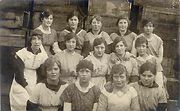 Donated by Mr. Keith Bloomfield
Donated by Mr. Keith BloomfieldDated 1918
Written on the back of this group photograph of First World War Muntions Factory workers, taken just after the end of the war, is: "With best wishes from the girls at White's, 17th December 1918".
More detail » Normanhurst - VAD Hospital
Normanhurst - VAD Hospital
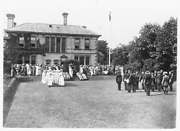 Donated by Douglas Ferriday
Donated by Douglas FerridayPart of the Hartlepool Library Service collection
Dated 1915
Normanhurst shown in 1915, when it was in use as a VAD (Voluntary Aid Detachment) Hospital for injured soldiers during the First World War.
HHT&N 65
More detail » Peace Tea
Peace Tea
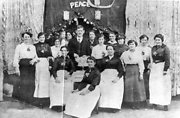 Donated by Douglas R.P.Ferriday
Donated by Douglas R.P.FerridayDated 1919
Peace Tea to celebrate the end of the First World War, 1919. The gentleman in the centre is Eddie Curran, landlord of The Dock Hotel.
HHT+N 15
More detail » Peace Teas, 1918 - by Kirsten Luckins
Peace Teas, 1918 - by Kirsten Luckins
“Elsewhere, hardly another generation will see the shell-holes mortared up, the trenches smoothed out, the streets laughing with the good cheer of honest labour”. From ‘Under German Fire’,
When it’s all over, things will be
in rightful places. In the sidings
the strewn shreds, light as tobacco flakes
will re-wind into waggonloads of rope.
At The Willows, the wrought iron gates
will re-fuse their ornate tracery behind
the six-foot sleeper as it retracts
its oaken bulk back across Hartlepool Road.
As far away as Trimdon or Pudding Poke,
the soft fields will relinquish ordinance
they had tucked intact in their cleavage,
so it may be ruled ‘Property of the Kaiser’,
waggishly offered for collection in person.
The Baptist organ will fall dormant,
that one beautiful shell-struck chord
will re-coil into the smashed façade,
bricks darning the aperture.
Melodies will lie docile in the throats of pipes
waiting for instructions, like women
who have returned from factories to sit
beside the lit home fires, watching
for the demobbed in their former clothes.
Sons will be home by Christmas, fathers
sit once more in the carver, limbs
will re-attach to Belgian trees, barbaric Huns
will remain inside re-drawn lines,
medals will pinpoint all the right chests.
The black crude of Persia will flow
into our coffers, all coffins eventually
will be re-ordered into respectful avenues.
Trestle tables will take to our streets,
vindication will sweeten our cups of tea.
More detail » Propaganda balloons
Propaganda balloons
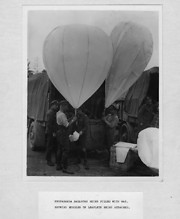 Part of the Hartlepool Museum Service collection
Part of the Hartlepool Museum Service collectionOne of a series of photos in the museum collection showing propaganda balloons being prepared for dispatch over enemy lines. Photo is probably not local?
More detail » Recollections of The Bombardment by Beryl Branson
Recollections of The Bombardment by Beryl Branson
Recollections of The Bombardment of The Hartlepools by the late Beryl Osbourn nee Branson
Beryl Branson was the daughter of John Branson the owner and principal of Osborne High School ,Osborne Road Hartlepool. She herself became a teacher and although she started her career at Brougham and the Open Air School Hartlepool, she spent most of her career in West Yorkshire.
This is her recollection of December 16th 1914 which is from an exercise book in Hartlepool Library Archives and was probably written in the 1960s. She was about 10 years old at the time of The Bombardment. She was born in 1905 and died in Halifax in 1995.
"It was said recently that we older generation are history. Perhaps today there are few people left for whom the date December16th 1914 has any significance. In that year it happened to fall on a Wednesday and we were dressing, having risen just before 8 a.m. I think I was the only one still upstairs when, soon after 8 o clock there was a sound of gunfire. This hurried me downstairs more quickly than usual and we all sat down to breakfast. My father reassured us by saying that it was only practice with the guns at the battery at Hartlepool situated on the Headland behind the lighthouse.
There were louder bangs which rattled the windows after we sat down and the gas light, which was on as it was a dark winter morning, went down and finally went out.
I sat down to put on my boots ready for school. They were long and laced with the laces hooked round studs after the first few eyelet holes. However I was told that I was certainly not going to school while all the firing was going on and I can remember crying T that news- more probably because I was frightened that something was happening.
When the firing ceased shortly before 9 a.m.my father went to his school, which was near where we lived, to see if any of the boys were there. He found several that had come in by train. They must have had a lucky escape as the station had been hit. I can remember later seeing a large hole in the back of the station. Dad sent the boys straight home by the next train, to allay the fear of parents who must have heard the gunfire from their homes further north.
As dad could see the flames from the direction of the gas works, towering over the houses, he was anxious about his brother and family and his father, who all lived near the blazing gas holders,so he walked over there to see whether they were all right. The house next door to grandpa's had an exploded she'll in the upper story and the occupant, Mr Abbott, was wounded in the leg. I think the only damage at grandpa's was a cracked window.
My uncle and his family had run across the field behind their house and taken refuge I an old lime kiln in the quarries. They had a large piece of shell coming through their bedroom ceiling right over the bed which they had been in a short time before. Later they had a dug out made in the side of a tank nearer the house - a lovely place to play in !
With dad out of the way, I persuaded my mother to let me go to school, which was not far away at the junction of Dalton St and York Rd. Last time I saw it, it was a cycle shop! Two or three girls arrived at the same time and we read a notice on the door,'No more school this term'. It was not long before the Christmas holidays anyway.
We decided to walk around to see what we could of any damage that had been done. I remember we went along Murray St where there were several damaged shops nod lots of broken windows. I can recollect for years afterwards the road used to sparkle with glass splinters on moonlit nights. Remember we had a black out in the first war, being on the coast. We also saw the damage in Milton Road to Mr Mustard's tailor's shop. By then I expect we felt it was dinner time and drifted off home where I was in serious trouble for not reporting straight back from school.
On the Friday, two days after the Bombardment, a rumour went round the town that German battleships were coming again. Remember we had no radio in those days (in fact the few amateurs who experimented with broadcasting to each other had their sets confiscated if they had not dismantled or hidden them) . Few people were on the telephone, but rumour spread like wildfire from neighbour to neighbour and people living in what they felt were the more vulnerable parts of the town started walking to where they felt safer, into the country or to relatives living in the more easterly parts.
It was said that my great aunt, who lived with her brother in Brougham Terrace arrived at her sister in law's house carrying an eiderdown and grandpa's best trousers over her arm!
However, nothing happened and people began to calm down again, though some left to live in inland places and find not return.
We also had Zeppelin raids later in the war and many an air raid warning, when our warden would give the All Clear signal by riding round on his motor cycle giving three toots on his horn from time to time in each street. We used to come downstairs during raids or warnings and sit under the thick oak dining table while my mother read to us from Ivanhoe, the White Company or similar stirring tales.
My father often stood just inside the front door to see where the Zeppelin was and on one occasion I remember him shouting, ' it's hit!' We dashed out to look and I can remember seeing this huge airship on fire from end to end. Then it bent in the middle and disappeared from sight behind the houses, eventually falling into the sea. A lucky escape for the town. For years I had a piece of aluminium dredged up by a trawler but unfortunately it was lost when I removed from West Hartlepool and left in the drawer of a cabinet that was sold.
More detail » Robert and Alice Wainwright - 1908
Robert and Alice Wainwright - 1908
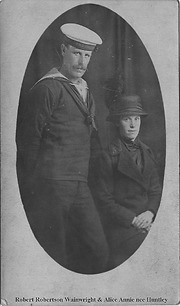 Created by unknown
Donated by Mr. Neil Wainwright
Created by unknown
Donated by Mr. Neil WainwrightRobert Robertson Wainwright and his wife Alice Annie (nee Huntley), during his naval service. Robert's cap band shows HMS Pembroke, the Naval Barracks at Chatham, which he returned to for training between ship postings. Robert served on a number of ships, including HMS Duncan (1914-15); HMS Apollo (1915-16); and HMS Crescent (1916-18).
More detail » Silver Street Peace Tea
Silver Street Peace Tea
 Donated by Mr. Brian Tunstall
Donated by Mr. Brian TunstallDated 1919
A Peace Tea, held in Silver Street, 'old' Hartlepool in 1919. This was one of a number of such events held to mark the end of the First World War.
More detail » St Joseph's School in two world wars
St Joseph's School in two world wars
ST. JOSEPHS IN A WORLD AT WAR
F.C.J. Annals 1914
‘There was no sound of carol singing or other music in the streets, for the shades of death and suffering lay over Hartlepools. Heart rending details still reach us’.
‘To our great grief we heard that one of our little ones had been killed. When her house was struck by a shell, she and her sister aged four, escaped from the Mother and ran into the street, only to meet her death…. The younger one said: ‘Maggie’s leg fell off – she then sat down and went to sleep, and opened her eyes and died….A child from the infant’s school was so badly injured that her arm had to be amputated in the workhouse hospital.
On the morning of the 18th there was a panic caused through a false report that the Germans were again upon us. The people, terrified by the experiences of the 16th, fled from their homes wild with fear, On our way to school we met women half clothed, unwashed, trailing their children after them and carrying such of their belongings as they could pick up. It took some hours to reassure and calm them and to prevail upon them to return to their homes; but there was no more school after that. We closed for the holidays and returned on the following Monday to put all in order. Great was our astonishment on finding the playground full of children. On being asked what brought them back: The Goose, Mother, the Party! They called out. Not to disappoint them we raffled the goose which fell to the lot of a poor fatherless child. We postponed the party till after the return’.
1915 ‘Attendance is poor after the bombardment. School starts at 9.30 in case there is another attack. Attendance officers’ weekly report sometimes says ‘left town’, ‘scared to death’ ‘suffering from bombarditis’. Tea party encouraged nearly all to return! ‘There is scarcely a child without someone in the firing line.’‘No meetings of the Guild of St. Agnes in the evenings as the unlit streets are unsafe’.
There was still time for celebration even in the darkest days of war. ‘Empire day celebrated with flags and patriotic songs. One passer by said’ I have been round several schools but yours beats them all’.’ ( F.C.J. Annals 1915)
Mr. W. Thomas left the school in 1915 to join the Navy.
The war provided the opportunity for some recycling 1916 style!! The school staff and children were asked to do some government work for the soldiers.‘O gruesome thought’ the staff and children of the school had been asked to make sacks from old dirty sacks of different sizes that would be filled with chaff and used for bayonet practice. ‘Of course all other work had to be set aside and for some days the school not only looked but smelt like a rag warehouse. There were sacks to the right of us and sacks to the left all day long…Of course the children were delighted and never attended so well or so early….One child pricked her finger and blood poisoning ensued but with no serious results.’ ’ ( F.C.J. Annals 1916)
In a raid ‘one of the teachers injured and everything in her house destroyed except a picture of St. Anthony on the wall’.
‘Through out the year the older girls worked hard knitting scarves socks and mittens, one of the parents said ‘what with this knitting we can’t get the children to do nothing else’. Each month the children received honourable mention in the Mail and 2 of the teachers were presented with brooches with the letters WW (War work) – making head bandages for the VAD and lunch bags for the soldiers rations’.
14th, 15th and 18th of March 1918
‘…Air raid last night. Bomb fell near the school and shattered all windows at East end of the school. Not possible to carry on this morning.’
‘…Guard of soldiers in one of the rooms to protect the property’.
‘Found school in use as military billet for soldiers guarding the houses near…classes compressed into four rooms and work proceeds’.
The end of the War was a cause for great rejoicing. In November 1918, all the ‘Picture Halls (were) open free to children every afternoon during the week in honour of the conclusion of the war. Only 82 children attended school that week’. There were Peace Teas, parades and celebrations throughout the town.
In 1919, ‘Mr. Thomas Connolly returned after three years army service. He obtained a commission and was badly wounded in the ankle but is now happily recovered.’ There is no mention of Mr. Thomas who joined the Navy in 1915.
In 1921 there must have been great sadness mingled with pride as a memorial tablet was unveiled in honour of ‘102 boys of St. Joseph’s who fell in the Great War’.
Second World War
June 20th 1940 St. Joseph’s Boys’ school log book
‘During the night an air raid took place. A bomb dropped in Whitby St., close to the east end of the Boys Dept., caused very considerable damage to the whole building , so that it is most improbable that the present buildings will ever be used again.
After reporting the extent of the damage to the Education Offices, the teachers proceeded to salvage as much as possible. We were able to remove from the Headmaster’s room, which was completely wrecked, all the permanent records, Log Book, Admission Registers etc. etc.
June 21st and 22nd
Work of salvage continued – saving as much as possible of the perishable stock. Rain on June 21st damaged much of stock.
‘On the night of 19th June 1940, 12. 10 Am., six high-explosive bombs were dropped in the streets and on the houses in the neighbourhood of St. Joseph’s school. The school was shattered, window panes blown in etc. It was impossible to use the school. For one week the teachers attended daily, doing salvage work under very difficult conditions….after about a fortnight, classes were held in the Corporation Hall, Pilot St.; The Guides Hall, Osborne St.; Miss Egglestone’s, Surtees St., and two classrooms in the Convent Grounds. (St. Joseph’s girl’s school log book)
In 1940 Mr. Coleman, Mr. Beldon and Mr. Timlin were called up for military service.
Many of the children had Fathers fighting around the globe and had not seen them for years. The F.C.J. Annals of 1944 tell a sad tale. ‘One of the priests present at the Christmas party, a Chaplain to the Forces and a former curate of St. Joseph’s Parish, was claimed by several of the “fives” and “sixes” --- “He’s my daddy”. “No, he’s not, he’s mine”, and they crowded round him, attracted by the uniform which they had perhaps seen their daddy wear. It was very pathetic: many of the children have no remembrance of their father.’
More detail » William Huntley Wainwright
William Huntley Wainwright
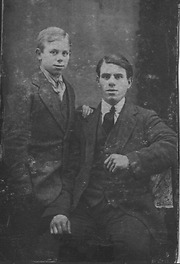 Created by unknown
Donated by Mr. Neil Wainwright
Created by unknown
Donated by Mr. Neil WainwrightDated 1915
William Huntley Wainwright (on the left), with his Uncle Joseph Huntley (William's mother's brother), taken around 1915.
More detail »




